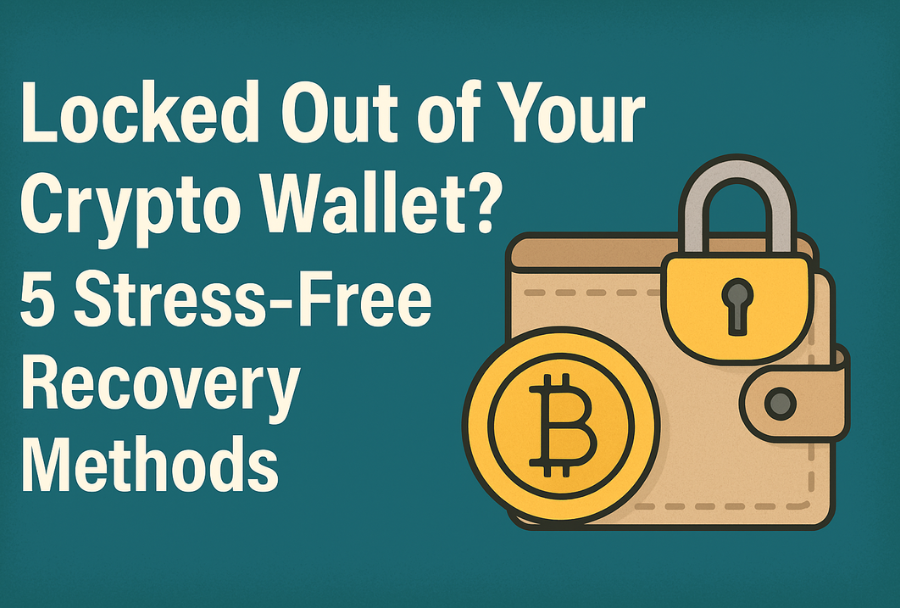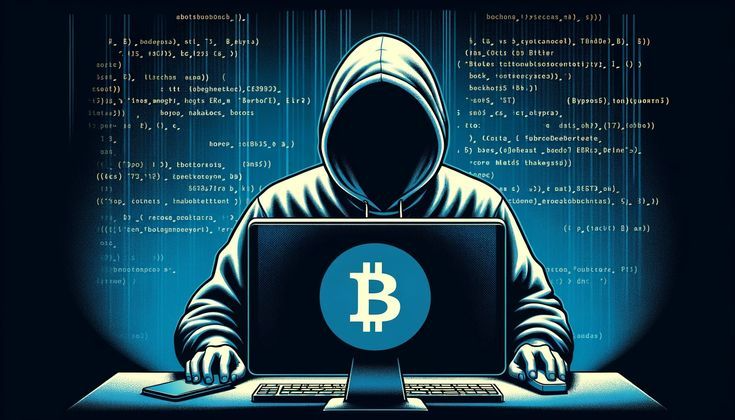Tech
Locked Out of Your Crypto Wallet? 5 Essential, Stress-Free Recovery Methods for Quick Access

Getting locked out of your crypto wallet is one of the most stressful experiences any cryptocurrency user can face. In a space where control over your digital assets is entirely in your hands, losing access can feel like losing everything Locked Out of Your Crypto Wallet.
Unlike traditional bank accounts that have customer support and password reset options, crypto wallets operate on principles of decentralization and privacy, which means no one else holds the master key to your funds but you. This unique structure is both a blessing and a curse — it provides security and ownership, but also puts the full responsibility for safeguarding your wallet on your shoulders Locked Out of Your Crypto Wallet.
So, when you suddenly find yourself unable to get into your wallet due to a forgotten password, misplaced recovery phrase, or technical issues, the panic and frustration are understandable. However, it’s important to remember that losing access doesn’t necessarily mean losing your cryptocurrency forever. The blockchain itself securely records your ownership, and with the right knowledge and tools, you can often recover your wallet access without losing your funds Locked Out of Your Crypto Wallet.
Many users get locked out of their wallets for common reasons such as forgetting passwords or PINs, losing their recovery seed phrase, experiencing corrupted wallet files, hardware wallet malfunctions, or falling victim to phishing attempts. The seed phrase, also called a mnemonic phrase or backup phrase, is arguably the most critical piece of information for wallet recovery — it’s essentially a master key that regenerates your wallet and all associated addresses Locked Out of Your Crypto Wallet.
Losing this phrase is the most serious problem because without it, recovering your wallet becomes extremely difficult or even impossible. But even if you’ve lost your password or run into software glitches, there are several proven methods you can try. What’s vital is to approach the situation calmly and methodically to avoid mistakes that could permanently lock you out or expose you to scams Locked Out of Your Crypto Wallet.
The fear of losing access to your crypto wallet can lead to rash decisions. Many fall victim to fraudulent recovery schemes promising to “unlock” wallets for a fee, only to lose their funds entirely. It’s crucial to maintain caution and never share private keys or seed phrases with anyone. Official wallet providers rarely offer recovery of private keys because they don’t hold them. This means you need to rely primarily on your own backups or use trusted recovery tools designed specifically for your wallet type.
Before trying any recovery step, gather all the information you have about your wallet—any backups, recovery phrases, passwords, or details about your wallet software or hardware. Having these ready will streamline the process and help you avoid unnecessary stress.
One of the most reliable recovery methods is to use your recovery seed phrase. If you have this phrase safely stored somewhere, even if you’ve forgotten your wallet password, you can restore your wallet on another device or compatible wallet software by inputting the seed words in the correct order. This is why experts emphasize writing down your seed phrase carefully and storing it securely offline in multiple places.
If you don’t have your seed phrase, the next best step depends on what type of wallet you use. Some wallets provide password recovery options or hints, and there are tools designed to perform safe brute-force attempts to recover forgotten passwords. However, these methods can take time and technical knowledge Locked Out of Your Crypto Wallet.
For hardware wallets like Ledger or Trezor, recovery typically involves using your seed phrase to restore the wallet onto a new device. If your hardware wallet is damaged or lost, having that seed phrase is critical to regain access.
Software wallets may allow you to restore from backup files saved on your computer or cloud storage, provided they weren’t corrupted. In some cases, official wallet support services may provide guidance or tools to assist with recovery, especially if you can verify ownership or provide transaction details. While there is no universal “password reset” in crypto, these resources can be helpful for certain wallet types Locked Out of Your Crypto Wallet.
If all standard recovery methods fail or seem too complex, professional crypto wallet recovery services exist to help users recover access to locked wallets. These services often use advanced forensic techniques, password recovery tools, or brute-force algorithms to retrieve wallets locked by forgotten passwords or corrupted files.
However, it’s essential to use only reputable companies with strong track records and never share your seed phrase or private keys with unverified parties. Do thorough research and seek recommendations from trusted crypto communities before entrusting anyone with your sensitive data Locked Out of Your Crypto Wallet.
While this guide focuses on recovery after being locked out, prevention remains the best strategy. Good habits like securely backing up your seed phrase, using hardware wallets for large holdings, utilizing password managers, and avoiding digital copies of sensitive information can dramatically reduce the risk of being locked out.
Consider writing your recovery phrase down on physical paper or metal plates designed to withstand damage, and keep copies in different safe locations. Regularly updating wallet software and firmware also helps prevent technical issues that could cause access problems Locked Out of Your Crypto Wallet.
In conclusion, getting locked out of your crypto wallet can feel devastating, but it’s not necessarily the end. With the right approach and knowledge of available recovery methods, you can regain access without losing your digital assets. The decentralized blockchain networks protect your ownership, and your job is to find the right “key” again — whether it’s your seed phrase, backup files, password hints, or professional help.
Most importantly, stay calm and avoid sharing sensitive information with unknown parties. Crypto recovery can be a process, but it’s often achievable with patience and care. The following sections will break down five stress-free methods for wallet recovery, providing you with practical steps and tips so you can confidently unlock your wallet and get back on track with your crypto journey Locked Out of Your Crypto Wallet.
Table of Contents
Method 1: Recovering Your Wallet Using Your Seed Phrase

What Is a Seed Phrase and Why Is It Important?
A seed phrase — sometimes called a recovery phrase, mnemonic phrase, or backup phrase — is a series of 12, 18, or 24 words generated when you first create your crypto wallet. This phrase acts as the master key to your wallet, allowing you to regenerate all your private keys and access your funds on any compatible device or wallet software Locked Out of Your Crypto Wallet.
Because it’s the ultimate backup, your seed phrase is the single most critical piece of information for recovering your wallet. If you lose it, you risk permanently losing access to your funds Locked Out of Your Crypto Wallet.
How Seed Phrase Recovery Works
When you lose access to your wallet — perhaps due to a forgotten password or a lost device — you can use the seed phrase to restore your wallet from scratch. Wallets like MetaMask, Trust Wallet, Ledger, Trezor, and many others rely on the seed phrase as the foundation for key recovery Locked Out of Your Crypto Wallet.
Step-by-Step Guide to Recover Using Your Seed Phrase
- Download and install the wallet software you originally used or another compatible wallet app.
- Choose the “Restore wallet” or “Import wallet” option.
- Enter your seed phrase words exactly as they were given, in the correct order.
- Create a new password or PIN for wallet security.
- Wait for the wallet to synchronize with the blockchain — your funds and transaction history will appear once synced.
Common Mistakes to Avoid
- Entering the seed phrase incorrectly — misspelling words or mixing up the order.
- Storing the seed phrase insecurely, such as unencrypted digital notes or photos on your phone.
- Sharing your seed phrase with others — never share your seed phrase online or with anyone claiming to be “support.”
- Ignoring backups — if you don’t have a physical or secure digital backup of your seed phrase, recovery will be impossible.
What If You Lost Your Seed Phrase?
Unfortunately, if you lose your seed phrase, your chances of recovery plummet drastically. Seed phrases are designed to be the only way to restore wallets without third-party help. That’s why it’s essential to store your seed phrase safely in multiple physical locations — think encrypted USB drives, paper backups in a secure place, or even safety deposit boxes Locked Out of Your Crypto Wallet.
If you lost your seed phrase, don’t lose hope. Keep reading to discover alternative recovery methods, including social recovery wallets and hardware wallet solutions that can help Locked Out of Your Crypto Wallet.
Method 2: Hardware Wallet Recovery Options
What Are Hardware Wallets?
Hardware wallets like Ledger Nano S, Ledger Nano X, and Trezor are physical devices that store your private keys offline, providing superior security against hacking and malware. They come with built-in recovery features but also pose unique challenges if lost or damaged Locked Out of Your Crypto Wallet.
How to Recover a Hardware Wallet
Most hardware wallets provide you with a seed phrase when you first set them up, which you should store securely. If your device is lost, stolen, or damaged, you can use this seed phrase to recover your wallet on a new hardware wallet or compatible software wallet Locked Out of Your Crypto Wallet.
Steps to Recover on a New Device
- Purchase a new compatible hardware wallet or install wallet software that supports your device’s seed phrase standard Locked Out of Your Crypto Wallet.
- Choose the “Restore from recovery phrase” option during setup.
- Carefully enter your seed phrase words in order.
- Set up a new PIN or password for device security.
- Confirm recovery — your wallet will be restored with all your funds and transaction history.
Using Device Recovery Modes and PIN Reset
Some hardware wallets allow limited options to reset PINs or use recovery modes if you forget your PIN. For example:
- Ledger devices allow PIN reset but require the recovery phrase to restore funds.
- Trezor devices can be reset if you have your seed phrase.
If you don’t have your seed phrase, even hardware wallets cannot recover your funds, highlighting the importance of secure backup Locked Out of Your Crypto Wallet.
Contacting Hardware Wallet Support
If you’re facing issues with your hardware wallet, such as firmware glitches or device malfunction, contact the manufacturer’s official support channels immediately. Beware of scammers impersonating support Locked Out of Your Crypto Wallet.
Tips to Avoid Hardware Wallet Lockouts
- Always write down your seed phrase and store it securely.
- Avoid storing your seed phrase digitally unless encrypted.
- Keep your hardware wallet firmware updated.
- Test recovery on a secondary device if possible to confirm your backups.
Method 3: Using Social Recovery Wallets and Multi-Signature Setups
What Are Social Recovery Wallets?
Social recovery wallets are a new innovation designed to help users regain access if they lose their private keys or seed phrases. Instead of relying solely on one key, these wallets allow you to appoint trusted contacts (“guardians”) who can help you recover your wallet by approving a recovery request Locked Out of Your Crypto Wallet.
Examples include wallets like Argent and some multi-signature wallet setups like Gnosis Safe.
How Social Recovery Works
- You select trusted friends or family as your guardians.
- If you lose access, you initiate a recovery request.
- Your guardians confirm your identity by approving recovery on their devices.
- After enough approvals (usually a majority), your wallet access is restored.
Multi-Signature Wallets Explained
Multi-signature wallets require multiple keys to authorize transactions. This reduces risk since no single compromised key grants access Locked Out of Your Crypto Wallet.
For example, a 3-of-5 multi-sig wallet requires at least three keys out of five to sign transactions or approve recovery Locked Out of Your Crypto Wallet.
Step-by-Step Social Recovery Process
- Initiate the recovery on your wallet app.
- Notify your guardians to approve the request.
- Once the threshold is met, your wallet resets with a new recovery key or password.
- Regain full access.
Pros and Cons
Pros:
- Adds social backup layer.
- Reduces risk of losing access permanently.
- No need to store seed phrase physically.
Cons:
- Requires trust in chosen guardians.
- Setup can be complex for beginners.
- Not supported by all wallets.
Common Reasons People Get Locked Out of Crypto Wallets
Before exploring recovery methods, it’s essential to understand why wallet lockouts happen:
- Forgetting passwords or PINs: Many wallets require strong passwords that are easy to forget if not stored safely.
- Losing or misplacing the seed phrase: The 12-24 word seed phrase is crucial for wallet recovery; losing it often means losing access forever.
- Device theft or loss: If your wallet is stored on a phone or hardware device that gets lost or stolen, accessing your funds becomes challenging without backup.
- Software glitches or wallet app errors: Bugs, corrupted files, or failed updates may prevent you from opening your wallet.
- Falling victim to phishing or scams: Entering private keys or passwords on malicious sites can lead to compromised wallets.
- Complex wallet setups: Multi-signature wallets and other advanced configurations can confuse users who are not fully aware of the recovery process.
Understanding these pitfalls can help users prepare better and avoid lockouts Locked Out of Your Crypto Wallet.
How to Prevent Getting Locked Out of Your Crypto Wallet
Prevention is always better than cure. Here are some best practices:
- Backup your seed phrase securely: Write it down on paper, store it in a fireproof safe, or use a metal seed phrase backup kit.
- Use password managers: Safely store complex passwords in encrypted password manager apps.
- Enable multi-factor authentication (MFA): Where wallets or exchanges support MFA, enable it for extra security.
- Keep wallet software updated: Regularly update your wallet app and device firmware to avoid bugs.
- Educate yourself about scams: Recognize phishing emails, fake websites, and social engineering attempts.
- Test recovery plans: Simulate a recovery on a test wallet to understand the process and reduce panic if locked out.
Taking these steps will significantly reduce the chances of losing access to your funds.
Understanding Wallet Types and Their Recovery Features
Not all wallets are created equal. Knowing the differences helps with recovery:
- Hot wallets: Connected to the internet and often more user-friendly but vulnerable to hacks. Seed phrases or passwords can recover access.
- Cold wallets: Offline storage devices like hardware wallets. Recovery depends entirely on the seed phrase, making it vital to keep it safe.
- Custodial wallets: Provided by exchanges or services that hold private keys for you. Recovery is often through customer support and identity verification.
- Non-custodial wallets: You hold your keys. Recovery depends entirely on your knowledge and safekeeping of seed phrases or backup keys.
- Multi-signature wallets: Require multiple private keys to approve transactions. Recovery can be complex if one or more keys are lost.
Knowing your wallet type’s recovery options prepares you for quick action in case of loss.
5 Stress-Free Crypto Wallet Recovery Methods

1. Using Your Seed Phrase / Recovery Phrase
The most common and secure way to regain access. Enter your 12-24 word seed phrase into a compatible wallet app to restore your wallet and funds.
2. Password or PIN Reset (Custodial Wallets)
If your wallet is managed by a service, use their password reset via email, phone, or security questions. Some wallets also allow biometric resets.
3. Social Recovery Methods
Some wallets use trusted contacts who can approve recovery requests if you lose access. Examples include Argent Wallet’s social recovery feature Locked Out of Your Crypto Wallet.
4. Hardware Wallet Recovery
Using your seed phrase with a new hardware wallet device lets you restore access without original hardware.
5. Contacting Customer Support
For custodial wallets or exchange wallets, reaching out to official support can help regain access after identity verification.
How to Safely Use Third-Party Wallet Recovery Services
Some companies claim to recover lost wallets but beware:
- Avoid scams: Many fake services promise wallet recovery for a fee but steal your info.
- Verify legitimacy: Check reviews, official certifications, and community feedback.
- Never share private keys: Legitimate services will never ask for your private key directly.
- Use trusted forums: Crypto communities like Reddit or BitcoinTalk can recommend vetted services.
- Backup before you try: Always keep backups before engaging any service.
What to Do If You Suspect Your Wallet Has Been Compromised
- Immediately move funds to a new wallet.
- Revoke approvals and connected apps.
- Change passwords and update security info.
- Notify exchanges and platforms if linked.
- Report scams or thefts to authorities or crypto forums.
Taking swift action can limit losses and secure your assets.
Legal and Ethical Considerations in Wallet Recovery
- Proving ownership can be difficult without proper documentation.
- In cases of deceased owners, estate planning is critical for access.
- Accessing wallets with multiple owners requires cooperation or legal steps.
- Always respect privacy and legality when attempting wallet recovery.
Case Studies: Real-Life Crypto Wallet Recovery Stories
- Success story: User lost phone but recovered wallet easily using seed phrase backup.
- Failure story: User lost seed phrase and could not access millions of dollars.
- Social recovery success: Argent wallet user regained access through trusted contacts.
- Hardware wallet mistake: User destroyed device but restored with seed phrase on new device.
Lessons highlight the importance of preparation and backups Locked Out of Your Crypto Wallet.
Future Trends in Crypto Wallet Recovery
- Biometric recovery: Fingerprints and facial recognition.
- Decentralized identity protocols: Self-sovereign identity controlling wallet access.
- Improved social recovery: More flexible multi-signature setups.
- Blockchain protocol enhancements: Better standards for recovery and security.
These trends promise easier and safer wallet management ahead.
Glossary of Key Crypto Wallet Terms
- Seed phrase: A set of words used to recover a wallet.
- Private key: The secret code giving access to crypto.
- Public key: The wallet address others send crypto to.
- Multi-signature: Wallet requiring multiple approvals.
- Hot wallet: Online wallet connected to the internet.
- Cold wallet: Offline wallet, often hardware-based.
- Phishing: Scam attempts to steal credentials.
Additional Resources and Tools
- Official recovery guides from Ledger, Trezor, MetaMask.
- Recommended password managers: LastPass, Bitwarden.
- Crypto security forums: r/cryptocurrency, Bitcointalk.org.
- Seed phrase backup kits: Cryptosteel, Billfodl.
1. Psychological Impact of Losing Access to Crypto Wallets

Losing access to a crypto wallet isn’t just about the technical challenge — it often causes significant emotional stress. Crypto wallets can hold life-changing amounts of money, and the fear of permanent loss can be overwhelming. Many users report feelings of anxiety, panic, frustration, and even helplessness when locked out Locked Out of Your Crypto Wallet.
Coping with Fear and Frustration
The key to overcoming this emotional hurdle is to stay calm and rational. Take deep breaths, step back, and remind yourself that recovery is often possible with patience and the right approach. Avoid rushing into risky shortcuts or sharing sensitive info with strangers Locked Out of Your Crypto Wallet.
Tips for Staying Calm in High-Pressure Situations
- Pause and breathe: Don’t let panic drive your decisions.
- Seek support: Talk to trusted friends or community members who understand crypto.
- Document everything: Write down what you remember about your wallet credentials.
- Educate yourself: Understanding wallet recovery options can reduce fear.
Stories of Recovery
Many crypto users have shared their journeys from despair to success. For example, a user who forgot their password but still had the seed phrase was able to recover their funds using software wallet tools. Another recovered after reconstructing partial seed phrases stored in multiple locations. These stories show that with persistence, recovery is often achievable Locked Out of Your Crypto Wallet.
2. How to Create a Robust Wallet Backup Plan
Prevention is better than cure. A strong backup plan can save you from wallet lockout.
Step-by-Step Backup Guide
- Write down your seed phrase: Immediately write your 12/24-word phrase on paper when setting up your wallet.
- Use metal backups: Transfer seed phrases to fireproof metal plates to prevent damage.
- Store encrypted USB backups: For software wallets, export encrypted wallet backups to USB drives.
- Create multiple copies: Don’t rely on a single backup. Store at least 3 copies in different secure locations.
Why One Backup Isn’t Enough
Single backups risk destruction or loss due to theft, fire, or accidents. Multiple geographically separated backups reduce risk dramatically.
Secure Sharing
If you want family or trusted friends to have recovery info, share it securely without exposing private keys online. Use sealed envelopes or secure password managers Locked Out of Your Crypto Wallet.
3. The Role of Multi-Signature Wallets in Security and Recovery
Multi-signature (multi-sig) wallets require multiple private keys to authorize transactions. This adds extra security but also complexity in recovery Locked Out of Your Crypto Wallet.
Protection Layers
By requiring, say, 2 out of 3 signatures, multi-sig wallets reduce risk of theft from a single compromised key.
Recovery Challenges
If one key is lost, recovery depends on how many signatures are needed. Losing too many keys can lock you out permanently Locked Out of Your Crypto Wallet.
Real-Life Examples
Some organizations use multi-sig wallets with keys held by different executives, allowing recovery through collaboration if one key is lost.
Best Practices
- Securely store all keys separately.
- Document who holds which key.
- Test recovery process periodically.
Incorporating Multi-Sig in Your Plan
Use multi-sig for high-value wallets but ensure you have a clear, documented recovery strategy for lost keys Locked Out of Your Crypto Wallet.
4. Comparison: Hardware Wallet vs Software Wallet Recovery
Hardware Wallets (Ledger, Trezor, Coldcard)
- Pros: Private keys never leave the device; very secure against hacks.
- Cons: If lost or damaged without backup seed phrase, recovery is difficult or impossible.
- Recovery: Seed phrase-based; no password recovery.
Software Wallets (MetaMask, Trust Wallet)
- Pros: Easy to set up and use; seed phrase backups.
- Cons: Vulnerable if device or passwords are compromised.
- Recovery: Seed phrase or password recovery options may exist.
Device Nature and Recovery
Hardware wallets are more secure but risk total loss if seed phrase isn’t backed up. Software wallets offer convenience but require strong password practices Locked Out of Your Crypto Wallet.
Choosing with Recovery in Mind
Pick wallets with clear, user-friendly recovery options. Always secure seed phrases offline regardless of wallet type Locked Out of Your Crypto Wallet.
5. Understanding Seed Phrase Formats and Compatibility
Seed Phrase Lengths
- 12, 18, or 24-word phrases are common.
- Longer phrases generally mean stronger security.
Mnemonic Standards
BIP39 is the most widely used standard for generating seed phrases.
Importing Across Wallets
You can often import seed phrases into different wallet software — but compatibility varies by standard.
Troubleshooting Compatibility
- Make sure you use the correct word order.
- Check for typos.
- Use wallet software that supports your seed phrase standard.
6. How to Safely Store Your Private Keys Offline
Cold Storage Methods
- Hardware wallets: The most secure.
- Paper wallets: Print or write keys on paper; store securely.
- Metal backups: Protects against fire and water damage.
Protection Tips
- Keep backups in secure, hidden places.
- Use fireproof and waterproof containers.
- Consider encrypting private keys with strong passwords Locked Out of Your Crypto Wallet.
7. How to Spot and Avoid Crypto Recovery Scams
Common Scams
- Offers promising guaranteed recovery for fees.
- Requests seed phrases or private keys.
- Fake support emails and websites.
Red Flags
- Unsolicited contact.
- Upfront payment demands.
- Pressure to act quickly.
Verifying Legitimate Services
- Check reviews and community forums.
- Use only official wallet recovery channels.
- Never share private keys Locked Out of Your Crypto Wallet.
What To Do If Scammed
Report to authorities, change passwords, warn the community.
8. Recovery Options When You Lose Both Seed Phrase and Password
Emergency Contacts and Social Recovery
Some wallets offer social recovery, allowing trusted contacts to help you recover access.
Mnemonic Fragments
Partial seed phrases stored in multiple places can sometimes be reconstructed.
Professional Crypto Forensic Services
Specialized firms may help but often charge high fees and can’t guarantee success.
Acceptance
If all recovery info is lost, the wallet may be unrecoverable. Avoid by planning backups.
9. What Happens If You Lose Access to Exchange Wallets?
Centralized Exchange Recovery
- Usually involves identity verification and KYC.
- Process can be slow.
- Limits on withdrawal amounts may apply.
Custodial Wallet Risks
You depend on the exchange’s security and policies.
Personal Wallets vs Exchange Wallets
Personal wallets offer full control but require personal responsibility for security and recovery Locked Out of Your Crypto Wallet.
10. How to Transfer Your Crypto After Recovery
Safe Transfer Steps
- Move funds to a new wallet with fresh keys.
- Use small test transactions first.
- Pay attention to network fees and congestion.
Confirming Recovery
Verify your full balance and transaction history.
Post-Recovery Security
Update passwords, enable 2FA, and revise your backup plan Locked Out of Your Crypto Wallet.
11. The Importance of Estate Planning for Crypto Assets
Preparing for Inheritance
- Document access details securely.
- Use multi-sig wallets with trusted heirs.
Legal Tools
- Will or trust specifying crypto assets.
- Consult with estate planning lawyers familiar with crypto.
Avoiding Asset Loss
Without proper planning, heirs may never access wallets, causing permanent loss Locked Out of Your Crypto Wallet.
12. Interviews and Quotes from Crypto Security Experts
Expert insights emphasize:
- Never share seed phrases.
- Regularly update backups.
- Use multi-sig for high-value wallets.
- Educate yourself on evolving threats.
Experts predict increasing integration of AI and decentralized identity solutions to ease recovery Locked Out of Your Crypto Wallet.
13. How Blockchain Technology Could Evolve Wallet Recovery
Decentralized Identity (DID)
Using blockchain-based digital IDs to verify wallet owners.
Smart Contracts for Recovery
Automating recovery with pre-set conditions.
Cross-Chain Management
Unified recovery tools for wallets across multiple blockchains.
AI Integration
Using AI to detect anomalies and assist in secure recovery steps.
14. Step-by-Step Guide: How to Set Up Social Recovery Wallets
Wallets Supporting Social Recovery
Argent is a popular example.
Choosing Guardians
Select trustworthy friends or family.
Setting Permissions
Decide how many guardians approve recovery.
Triggering Recovery
Guardians collectively authorize access restoration.
Risks & Benefits
Benefits: easier recovery without seed phrases.
Risks: trust in guardians is critical.
Video Section: Visual Guide to Crypto Wallet Recovery
To complement this guide, here are some carefully selected videos that walk you through key crypto wallet recovery techniques and tips. Watching these can provide a clearer understanding and step-by-step walkthroughs that are easier to follow than text alone Locked Out of Your Crypto Wallet.
15. Frequently Asked Questions (Expanded)

How long does wallet recovery take?
It varies from minutes (password reset) to days or weeks (seed phrase reconstruction).
Can law enforcement help recover lost crypto?
Only in cases of theft or fraud with evidence; otherwise, crypto is private and decentralized.
Are there legal consequences to unauthorized wallet recovery?
Yes, accessing wallets without permission is illegal.
What should I do if I forgot my wallet password but have the seed phrase?
Use the seed phrase to restore access in wallet software.
Is it possible to recover wallets on mobile vs desktop?
Yes, most wallets offer recovery on both platforms but steps may differ slightly.







